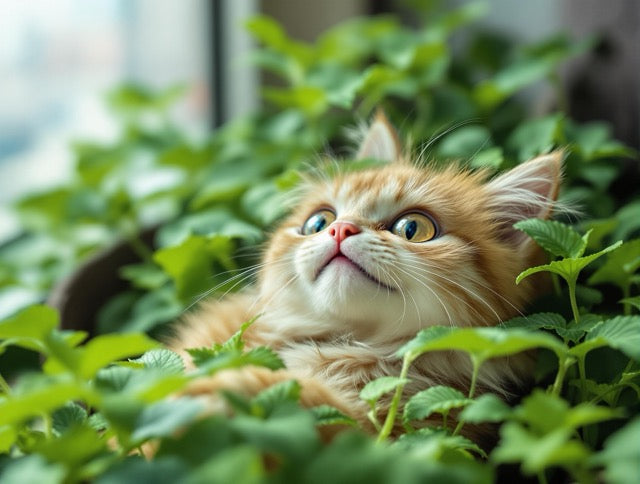
The Fascinating World of Catnip: Why Cats Go Crazy for This Magic Herb 🌿
Share
The Fascinating Catnip: Why Cats Go Wild for This Magic Herb 🌿
If you’ve ever seen your cat roll, purr, and act delightfully silly after sniffing catnip, you’ve witnessed one of nature’s most curious feline behaviors. Catnip — a simple green herb — has a remarkable effect on many cats, often turning even the calmest kitty into a playful whirlwind. But what exactly is catnip, why does it affect cats this way, and is it safe? Let’s explore!

Key Things to Know 💡
-
Catnip is 100% safe and natural for your cat! 🌿
-
~70% of cats respond to catnip - it's in their genes 🧬
-
There are many fun ways to share catnip with your furry friend 🐱
What Is Catnip?

Catnip (Nepeta cataria) is a member of the mint family and has been used for centuries — by both cats and humans. For felines, it’s a source of fun and enrichment. For people, it’s long been brewed into teas for relaxation and mild digestive support.
The magic of catnip lies in a chemical compound called nepetalactone, which is found in the plant’s leaves and stems. This natural oil is what triggers the playful reaction in cats.
How Does Catnip Affect Cats?
When a cat sniffs catnip, nepetalactone binds to receptors in their nasal tissue. This sends signals to the brain’s olfactory bulb, which influences behavior and emotion. The result? A short burst of excitement and playfulness — often followed by a calm, relaxed phase.
Common Catnip Reactions:
- Rolling, rubbing, or licking the catnip
- Playful running and jumping
- Vocalizing or purring
- A brief period of relaxation afterwards
These effects usually last about 10–15 minutes, after which your cat loses interest. It can take an hour or two before they respond again. Around 30% of cats don’t react to catnip at all — sensitivity is inherited and linked to genetics.
From Picky Eater to Happy Feaster!
Is your cat turning their nose up at mealtime? Our fresh, additive-free cat food, proudly made in Hong Kong, transforms even the pickiest eaters. Give them the gift of pure, wholesome goodness!
Discover Fresh Cat FoodSafe and Fun Ways to Use Catnip

Catnip is completely non-toxic and safe for cats of all ages. Still, moderation and creative use make it most enjoyable. Here are a few easy ideas:
- Catnip toys: Soft toys filled with dried catnip are perfect for supervised playtime.
- Scratching posts: Sprinkle a pinch on a scratching post to encourage healthy scratching behavior.
- Fresh plant: If you grow catnip at home, let your cat nibble a few leaves — but protect the plant, as some cats may try to roll in it!
Is Catnip Safe? Let's Talk Safety! 🛡️
Good news! Catnip is completely safe for cats. It's like their version of watching a funny cat video - harmless fun! 😊
Simple Tips:
- Offer catnip once or twice a week to keep it exciting.
- Store dried catnip in an airtight container to preserve freshness.
- Supervise kittens under six months, as their response may vary.
Is Catnip Safe for Humans?
Yes — but it won’t have the same effect! For humans, catnip tea can have a mild calming or digestive benefit. The active compounds act as gentle herbal relaxants, but they are not intoxicating. Always consult your healthcare provider before using herbal supplements if you’re pregnant or on medication.

What If My Cat Doesn't Like Catnip? 🤔
If your cat doesn’t seem interested, don’t worry — they’re perfectly normal. About one in three cats lack the gene that makes them sensitive to nepetalactone. Younger kittens (under 6 months) also may not respond yet. As an alternative, try silvervine or valerian root, which can trigger similar playful reactions in non-responders.
Get Pawsitive Tips in Your Inbox!
Subscribe to our newsletter for more expert advice, special offers, and heartwarming stories.
Final Thoughts & Tips 💭
Catnip is a safe, natural way to add enrichment and joy to your cat’s daily life. Used occasionally, it can encourage exercise, reduce stress, and strengthen the bond between you and your feline friend. Every cat is unique — so whether yours loves catnip or ignores it completely, they’re just being their wonderful individual self. 🐱
Frequently Asked Questions
How often can I give my cat catnip?
It's best to offer catnip as an occasional treat, about once or twice a week. This keeps it special and exciting for your cat. Overexposure can lessen its effects over time, so moderation is key to maintaining the fun.
My kitten doesn't react to catnip. Is something wrong?
No, nothing is wrong! The sensitivity to catnip is a genetic trait that doesn't typically develop until a kitten is between 3 to 6 months old. Furthermore, about 30% of adult cats don't have the gene for catnip sensitivity at all. Your kitten is perfectly normal.
Can a cat 'overdose' on catnip?
No, cats cannot overdose on catnip in a dangerous way. They are very good at self-regulating. If a cat has too much, the worst that might happen is mild digestive upset, like vomiting or diarrhea. They will typically walk away from the catnip once they've had enough.
⚠️ Disclaimer
This article is for informational purposes only and not a substitute for professional veterinary advice. Always consult your veterinarian about your pet’s health or behavior.
References
- Ellis, S. L. H., & Wells, D. L. (2010). The influence of olfactory stimulation on the behaviour of cats housed in a rescue shelter. Applied Animal Behaviour Science, 123(1–2), 56–62.
- McElfresh, J. S., & Eisner, T. (1997). Catnip: Its history and function as a cat attractant. Scientific American.
- eClinPath: Veterinary Clinical Pathology Online Resource
- ASPCA Pet Care Guide: https://www.aspca.org/pet-care/cat-care
